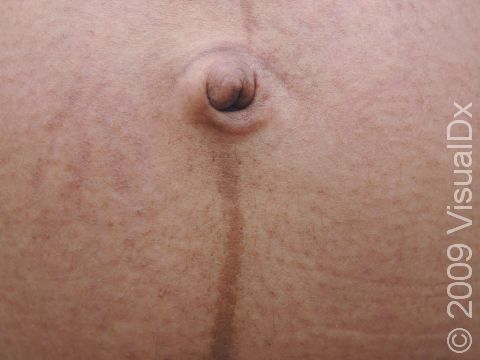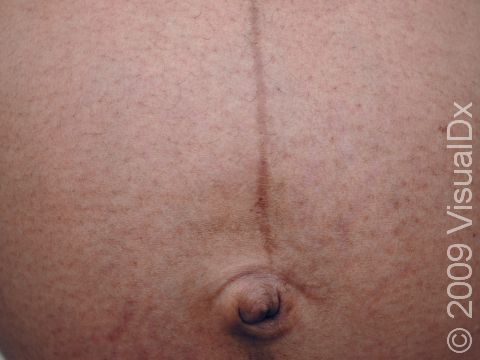Linea Nigra
Linea nigra is a dark vertical line that appears on the midline of the belly during pregnancy. It can extend from the top of the belly to the pubic area, running through the center of the belly button, or the line can be shorter. Increased hormones present during pregnancy stimulate increased pigment production, causing this area to darken. After the baby is born, linea nigra typically fades. In darker skin colors, this may take up to a year after pregnancy.
Who's At Risk?
Linea nigra tends to appear some time in the second trimester of pregnancy. It is more prominent in those with darker skin colors. It also occurs in individuals with lighter skin colors, although it may not be as noticeable.
Signs & Symptoms
The line of linea nigra is darker than the surrounding skin and a few millimeters to up to a centimeter in width. It can be quite dark or fairly light in color.
Self-Care Guidelines
No treatment is needed for linea nigra. The line should slowly fade after the baby is born. However, sun exposure can cause it to become darker or take longer to go away, so use sun protection factor (SPF) 30 or higher or keep your belly covered.
Treatments
Your medical professional will continue routine prenatal care.
Visit Urgency
No medical care is needed to treat linea nigra. Continue to take your prenatal vitamins and otherwise follow routine prenatal care guidelines.
References
Bolognia J, Schaffer JV, Cerroni L. Dermatology. 4th ed. Philadelphia, PA: Elsevier; 2018.
James WD, Elston D, Treat JR, Rosenbach MA. Andrew’s Diseases of the Skin. 13th ed. Philadelphia, PA: Elsevier; 2019.
Kang S, Amagai M, Bruckner AL, et al. Fitzpatrick’s Dermatology. 9th ed. New York, NY: McGraw-Hill Education; 2019.
Paller A, Mancini A. Paller and Mancini: Hurwitz Clinical Pediatric Dermatology. 6th ed. St. Louis, MO: Elsevier; 2022.
Last modified on May 15th, 2023 at 5:23 pm

Not sure what to look for?
Try our new Rash and Skin Condition Finder

